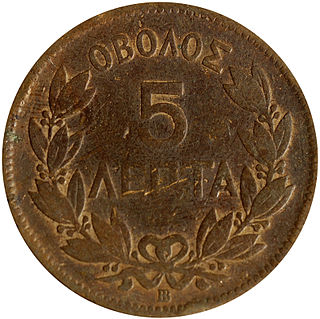Drachma was the currency used in Greece during several periods in its history:
- An ancient Greek currency unit issued by many Greek city states during a period of ten centuries, from the Archaic period throughout the Classical period, the Hellenistic period up to the Roman period under Greek Imperial Coinage.
- Three modern Greek currencies, the first introduced in 1832 and the last replaced by the euro in 2001. The euro did not begin circulating until 2002 but the exchange rate was fixed on 19 June 2000, with legal introduction of the euro taking place in January 2002.
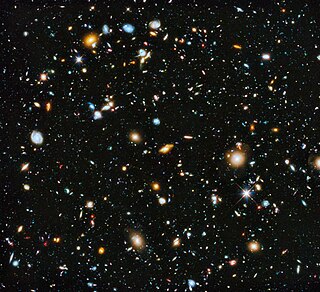
The Universe is all of space and time and their contents, including planets, stars, galaxies, and all other forms of matter and energy. While the spatial size of the entire Universe is unknown, it is possible to measure the size of the observable universe, which is currently estimated to be 93 billion light years in diameter. In various multiverse hypotheses, a universe is one of many causally disconnected constituent parts of a larger multiverse, which itself comprises all of space and time and its contents.

In particle physics, a pion is any of three subatomic particles:
π0
,
π+
, and
π−
. Each pion consists of a quark and an antiquark and is therefore a meson. Pions are the lightest mesons and, more generally, the lightest hadrons. They are unstable, with the charged pions
π+
and
π−
decaying with a mean lifetime of 26.033 nanoseconds, and the neutral pion
π0
decaying with a much shorter lifetime of 8.4×10−17 seconds. Charged pions most often decay into muons and muon neutrinos, while neutral pions generally decay into gamma rays.
The tau (τ), also called the tau lepton, tau particle, or tauon, is an elementary particle similar to the electron, with negative electric charge and a spin of 1/2. Together with the electron, the muon, and the three neutrinos, it is a lepton. Like all elementary particles with half-integer spin, the tau has a corresponding antiparticle of opposite charge but equal mass and spin, which in the tau's case is the antitau. Tau particles are denoted by
τ−
and the antitau by
τ+
.

Greece's first postal service was founded in 1828, at the time of Greek independence from the Ottoman Empire. This initial service continued mail delivery and, later, the issuing of postage stamps until 1970. It was then succeeded by the Hellenic Post S.A., which remains Greece's official postal provider. The first Greek stamps were issued in 1861; by then, the postal service had expanded to operate 97 branches.
In particle physics, lepton number is a conserved quantum number representing the difference between the number of leptons and the number of antileptons in an elementary particle reaction. Lepton number is an additive quantum number, so its sum is preserved in interactions. Mathematically, the lepton number
is defined by
, where
is the number of leptons and
is the number of antileptons.
In particle physics, preons are point particles, conceived of as subcomponents of quarks and leptons. The word was coined by Jogesh Pati and Abdus Salam in 1974. Interest in preon models peaked in the 1980s but has slowed as the Standard Model of particle physics continues to describe the physics mostly successfully, and no direct experimental evidence for lepton and quark compositeness has been found.
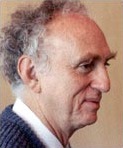
Martin Lewis Perl was an American chemical engineer and physicist who won the Nobel Prize in Physics in 1995 for his discovery of the tau lepton.
In particle physics, flavour or flavor refers to the species of an elementary particle. The Standard Model counts six flavours of quarks and six flavours of leptons. They are conventionally parameterized with flavour quantum numbers that are assigned to all subatomic particles. They can also be described by some of the family symmetries proposed for the quark-lepton generations.
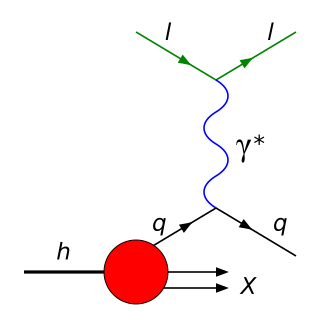
Deep inelastic scattering is the name given to a process used to probe the insides of hadrons, using electrons, muons and neutrinos. It provided the first convincing evidence of the reality of quarks, which up until that point had been considered by many to be a purely mathematical phenomenon. It is a relatively new process, first attempted in the 1960s and 1970s. It is an extension of Rutherford scattering to much higher energies of the scattering particle and thus to much finer resolution of the components of the nuclei.
In particle physics, a generation or family is a division of the elementary particles. Between generations, particles differ by their flavour quantum number and mass, but their interactions are identical.
Leptoquarks are hypothetical particles that carry information between quarks and leptons of a given generation that allow quarks and leptons to interact. They are color-triplet bosons that carry both lepton and baryon numbers. They are encountered in various extensions of the Standard Model, such as technicolor theories or GUTs based on Pati–Salam model, SU(5) or E6, etc. Their quantum numbers like spin, (fractional) electric charge and weak isospin vary among theories.

In physical cosmology, the lepton epoch was the period in the evolution of the early universe in which the leptons dominated the mass of the universe. It started roughly 1 second after the Big Bang, after the majority of hadrons and anti-hadrons annihilated each other at the end of the hadron epoch. During the lepton epoch the temperature of the universe was still high enough to create lepton/anti-lepton pairs, so leptons and anti-leptons were in thermal equilibrium. Approximately 10 seconds after the Big Bang the temperature of the universe had fallen to the point where lepton/anti-lepton pairs were no longer created. Most leptons and anti-leptons were then eliminated in annihilation reactions, leaving a small residue of leptons. The mass of the universe was then dominated by photons as it entered the following photon epoch.

In physical cosmology, the hadron epoch was the period in the evolution of the early universe during which the mass of the universe was dominated by hadrons. It started approximately 10−6 seconds after the Big Bang, when the temperature of the universe had fallen sufficiently to allow the quarks from the preceding quark epoch to bind together into hadrons. Initially the temperature was high enough to allow the formation of hadron/anti-hadron pairs, which kept matter and anti-matter in thermal equilibrium. However, as the temperature of the universe continued to fall, hadron/anti-hadron pairs were no longer produced. Most of the hadrons and anti-hadrons were then eliminated in annihilation reactions, leaving a small residue of hadrons. The elimination of anti-hadrons was completed by one second after the Big Bang, when the following lepton epoch began.

In physical cosmology, the photon epoch was the period in the evolution of the early universe in which photons dominated the energy of the universe. The photon epoch started after most leptons and anti-leptons were annihilated at the end of the lepton epoch, about 10 seconds after the Big Bang. Atomic nuclei were created in the process of nucleosynthesis which occurred during the first few minutes of the photon epoch. For the remainder of the photon epoch, the universe contained a hot dense plasma of nuclei, electrons and photons. 370,000 years after the Big Bang the temperature of the universe fell to the point where nuclei could combine with electrons to create neutral atoms. As a result, photons no longer interacted frequently with matter, the universe became transparent and the cosmic microwave background radiation was created and then structure formation took place.
The quark–lepton complementarity (QLC) is a possible fundamental symmetry between quarks and leptons. First proposed in 1990 by Foot and Lew, it assumes that leptons as well as quarks come in three "colors". Such theory may reproduce the Standard Model at low energies, and hence quark–lepton symmetry may be realized in nature.
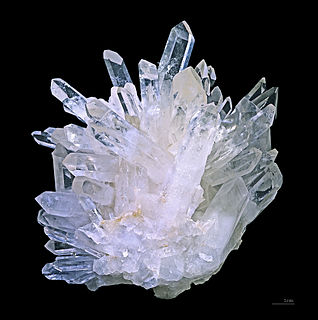
In classical physics and general chemistry, matter is any substance that has mass and takes up space by having volume. All everyday objects that can be touched are ultimately composed of atoms, which are made up of interacting subatomic particles, and in everyday as well as scientific usage, "matter" generally includes atoms and anything made up of them, and any particles that act as if they have both rest mass and volume. However it does not include massless particles such as photons, or other energy phenomena or waves such as light or sound. Matter exists in various states. These include classical everyday phases such as solid, liquid, and gas – for example water exists as ice, liquid water, and gaseous steam – but other states are possible, including plasma, Bose–Einstein condensates, fermionic condensates, and quark–gluon plasma.

